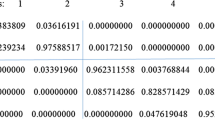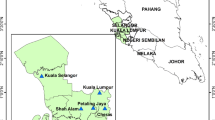Abstract
Modeling and evaluating the behavior of particulate matter (PM10) is an important step in obtaining valuable information that can serve as a basis for environmental risk management, planning, and controlling the adverse effects of air pollution. This study proposes the use of a Markov chain model as an alternative approach for deriving relevant insights and understanding of PM10 data. Using first- and higher-order Markov chains, we analyzed daily PM10 index data for the city of Klang, Malaysia and found the Markov chain model to fit the PM10 data well. Based on the fitted model, we comprehensively describe the stochastic behaviors in the PM10 index based on the properties of the Markov chain, including its states classification, ergodic properties, long-term behaviors, and mean return times. Overall, this study concludes that the Markov chain model provides a good alternative technique for obtaining valuable information from different perspectives for the analysis of PM10 data.







Similar content being viewed by others
References
Afroz, A., Hassan, M. N., & Ibrahim, N. A. (2003). Review of air pollution and health impact in Malaysia. Environmental Research, 92, 71–77.
Al-Dhurafi, N. A., Masseran, N., & Zamzuri, Z. H. (2018a). Compositional time series analysis for air pollution index data. Stochastic Environmental Research and Risk Assessment., 32(10), 2903–2911.
Al-Dhurafi, N. A., Masseran, N., Zamzuri, Z. H., & Razali, A. M. (2018b). Modeling unhealthy air pollution index using a peaks-over-threshold method. Environmental Engineering Science., 35(2), 101–110.
Al-Dhurafi, N. A., Masseran, N., Zamzuri, Z. H., & Safari, M. A. M. (2018c). Modeling the Air Pollution Index based on its structure and descriptive status. Air Quality, Atmosphere and Health, 11(2), 171–179.
Alyousifi, Y., Masseran, N., & Ibrahim, K. (2018). Modeling the stochastic dependence of air pollution index data. Stochastic Environmental Research and Risk Assessment., 32(6), 1603–1611.
Anderson, T. W., & Goodman, L. A. (1957). Statistical inference about Markov chain. The Annals of Mathematical Statistics., 28, 89–110.
Bartoletti, S., & Loperfido, N. (2010). Modelling air pollution data by the skew-normal distribution. Stochastic Environmental Research and Risk Assessment., 24, 513–517.
Biancofiore, F., Busilacchio, M., Verdecchia, M., Tomassetti, B., Aruffo, E., Bianco, S., Di Tommaso, S., Colangeli, C., Rosatelli, G., & Di Carlo, P. (2017). Recursive neural network model for analysis and forecast of PM10 and PM2.5. Atmospheric Pollution Research., 8, 652–659.
Bowerman, B. L., O’Connell, R. T., & Koehler, A. B. (2005). Forecasting, time series and regression, an applied approach (4th ed.). Belmont: Thomson Brooks.
Brunelli, U., Piazza, V., Pignato, L., Sorbello, F., & Vitabile, S. (2007). Two-days ahead prediction of daily maximum concentrations of SO2, O3, PM10, NO2, CO in the urban area of Palermo. Italy. Atmospheric Environment., 41, 2967–2995.
Chaloulakou, G. G. A. (2006). Artificial neural network models for prediction of PM10 hourly concentrations, in the Greater Area of Athens. Greece. Atmospheric Environment., 40, 1216–1229.
Chelani, A. B., Gajghate, D. G., & Hasan, M. Z. (2002). Prediction of ambient PM10 and toxic metals using artificial neural networks. Journal of the Air & Waste Management Association., 52, 805–810.
Ching, W.-K., Huang, X., Ng, M. K., & Siu, T.-K. (2013). Markov chain: models, algorithms and applications. International series in operation research & management science (2nd ed.). New York: Springer.
Daryanoosh, M., Goudarzi, G., Rashidi, R., Keishams, F., Hopke, P. K., Mohammadi, M. J., Nourmoradi, H., Sicard, P., Takdastan, A., Vosoughi, M., Veysi, M., Kianizadeh, M., & Omidi Khaniabadi, Y. (2018). Risk of morbidity attributed to ambient PM10 in the western cities of Iran. Toxin Reviews., 37(4), 313–318.
Department of Environment. (2000). A guide to air pollutant index in Malaysia (API). Kuala Lumpur: Ministry of Science, Technology and the Environment.
Di Menno, A., Bartoletti, S., Gaeta, A., Gandolfo, G., Caricchia, A., and Cirillo, M. (2007). Qualita` dell’aria in Italia il particolato sospeso PM10 anno 2005. http://www.apat.gov.it/site/it-IT/Temi/Aria/Documenti_tecnici/.
Ercelebi, S.G., & Toros, H. (2009). Extreme value analysis of Istanbul air pollution data. Clean, 37, 122–131.
Gin, O.K. (2009). Historical dictionary of Malaysia. Scarecrow Press, 157–158.
Gocheva-Ilieva, S. G., Ivanov, A. V., Voynikova, D. S., & Boyadzhiev, D. T. (2014). Time series analysis and forecasting for air pollution in small urban area: an SARIMA and factor analysis approach. Stochastic Environmental Research and Risk Assessment., 28(4), 1045–1060.
Google. (2019). Source : https://maps.googleapis.com/maps/api/geocode/json?address=Klang%2CSelangor&key=xxx.
Grinstead, C., & Snell, J. (2012). Introduction to probability. New York: American Mathematical Society.
Hamm, N. A. S., Finley, A. O., Schaap, M., & Stein, A. (2015). A spatially varying coefficient model for mapping PM10 air quality at the European scale. Atmospheric Environment., 102, 393–405.
Ibe, O. C. (2013). Markov processes for stochastic modeling (2nd ed.). Waltham: Elsevier.
Jeong, S. J. (2013). The impact of air pollution on human health in Suwon City. Asian Journal of Atmospheric Environment., 7, 227–233.
Kao, E. P. C. (1997). An introduction to stochastic processes. Belmont: Wadsworth Publishing Company.
Khaniabadi, Y. O., Goudarzi, G., Daryanoosh, S. M., Borgini, A., Tittarelli, A., & De Marco, A. (2017). Exposure to PM10, NO2, and O3 and impacts on human health. Environmental Science and Pollution Research., 24(3), 2781–2789.
Kisi, O., Parmar, K. S., Soni, K., & Demir, V. (2017). Modeling of air pollutants using least square support vector regression, multivariate adaptive regression spline, and M5 model tree models. Air Quality, Atmosphere & Health., 10(7), 873–883.
Korhonen, A., Lehtomäki, H., Rumrich, I., Karvosenoja, N., Paunu, V.-K., Kupiainen, K., Sofiev, M., Palamarchuk, Y., Kukkonen, J., Kangas, L., Karppinen, A., & Hänninen, O. (2019). Influence of spatial resolution on population PM2.5 exposure and health impacts. Air Quality, Atmosphere & Health., 12(6), 705–718.
Krishan, M., Jha, S., Das, J., Singh, A., Goyal, M. K., & Sekar, C. (2019). Air quality modelling using long short-term memory (LSTM) over NCT-Delhi, India. Air Quality, Atmosphere & Health., 12(8), 899–908.
Lin, K.-P., Pai, P.-F., & Yang, S.-L. (2011). Forecasting concentrations of air pollutants by logarithm support vector regression with immune algorithms. Applied Mathematics and Computation., 17(12), 5318–5327.
Manga, E., & Awang, N. (2018). Bayesian autoregressive spatiotemporal model of PM concentrations across Peninsular Malaysia. Stochastic Environmental Research and Risk Assessment, 32(12), 3409–3419.
Martins, L. D., Wikuats, C. F. H., Capucim, M. N., de Almeida, D. S., da Costa, S. C., Albuquerque, T., Barreto Carvalho, V. S., de Freitas, E. D., de Fátima Andrade, M., & Martins, J. A. (2017). Extreme value analysis of air pollution data and their comparison between two large urban regions of South America. Weather and Climate Extremes., 18, 44–54.
Masseran, N. (2017). Modeling fluctuation of PM10 data with existence of volatility effect. Environmental Engineering Science., 34(11), 816–827.
Masseran, N. (2018). Integrated approach for the determination of an accurate wind-speed distribution model. Energy Conversion and Management., 173, 56–64.
Masseran, N., & Safari, M. A. M. (2020a). Risk assessment of extreme air pollution based on partial duration series: IDF approach. Stochastic Environmental Research and Risk Assessment., 34, 545–559.
Masseran, N., & Safari, M. A. M. (2020b). Intensity-duration-frequency approach for risk assessment of air pollution events. Journal of Environmental Management, 264, 110429.
Masseran, N., Razali, A. M., Ibrahim, K., Zaharim, A., & Sopian, K. (2013). Application of the single imputation method to estimate missing wind speed data in Malaysia. Research Journal of Applied Sciences, Engineering and Technology., 6, 1780–1784.
Masseran, N., Razali, A. M., Ibrahim, K., & Latif, M. T. (2016). Modeling air quality in main cities of Peninsular Malaysia by using a generalized Pareto model. Environmental Monitoring and Assessment 188(1). Article number, 65, 1–12.
Mehdipour, V., Stevenson, D. S., Memarianfard, M., & Sihag, P. (2018). Comparing different methods for statistical modeling of particulate matter in Tehran, Iran. Air Quality, Atmosphere & Health., 11(10), 1155–1165.
Muñoz, E., Martín, M. L., Turias, I. J., Jimenez-Come, M. J., & Trujillo, F. J. (2014). Prediction of PM10 and SO2 exceedances to control air pollution in the Bay of Algeciras, Spain. Stochastic Environmental Research and Risk Assessment., 28(6), 1409–1420.
Nicolantonio, W. D., Cacciari, A., Bolzacchini, E., Ferrero, L., Volta, M., and Pisoni, E. (2007). Modis aerosol optical properties over north Italy for estimating surface-level PM2.5. Paper presented at the European Space Agency, (Special Publication) ESA SP, (SP-636).
Nieto, P. J. G., Combarro, E. F., del Coz Díaz, J. J., & Montañés, E. (2013). A SVM-based regression model to study the air quality at local scale in Oviedo urban area (Northern Spain): a case study. Applied Mathematics and Computation., 219(17), 8923–8937.
Park, S., Kim, M., Kim, M., Namgung, H.-G., Kim, K.-T., Choc, K. H., & Kwon, S.-B. (2018). Predicting PM10 concentration in Seoul metropolitan subway stations using artificial neural network (ANN). Journal of Hazardous Materials., 341, 75–82.
Pope, C. A., Burnett, R. T., Thun, M. J., Calle, E. E., Krewski, D., Ito, K., & Thurston, G. D. (2002). Lung cancer, cardiopulmonary mortality, and long-term exposure to fine particulate air pollution. Journal of the American Medical Association., 287(9), 1132–1141.
Reisen, V. A., Sarnaglia, A. J. Q., Reis Jr., N. C., Lévy-Leduc, C., & Santos, J. M. (2014). Modeling and forecasting daily average PM10 concentrations by a seasonal long-memory model with volatility. Environmental Modelling & Software., 51, 286–295.
Ross, S. M. (2014). Introduction to probability models (12th ed.). Burlington: Academic Press.
Safari, M. A. M., & Wan Zin, W. Z. (2017). Modelling of probability distributions of extreme particulate matter in Klang Valley. Sains Malaysiana., 46(6), 989–999.
Scholz, M. (2014). R Package clickstream: analyzing clickstream data with Markov chains. R package version, 1(1), 2.
Shahraiyni, H. T., & Sodoudi, S. (2016). Statistical modeling approaches for PM10 prediction in urban areas; a review of 21st-century studies. Atmosphere., 7(15), 1–24.
Thunis, P., Clappier, A., Pisoni, E., & Degraeuwe, B. (2015). Quantification of non-linearities as a function of time averaging in regional air quality modeling applications. Atmospheric Environment, 103, 263–275.
Ul-Saufie, A. Z., Yahaya, A. S., Ramli, N. A., Rosaida, N., & Hamid, H. A. (2013). Future daily PM10 concentrations prediction by combining regression models and feedforward backpropagation models with principal component analysis (PCA). Atmospheric Environment., 77, 621–630.
van de Kassteele, J., Koelemeijer, R. B. A., Dekkers, A. L. M., Schaap, M., Homan, C. D., & Stein, A. (2006). Statistical mapping of PM10 concentrations over Western Europe using secondary information from dispersion modeling and MODIS satellite observations. Stochastic Environmental Research and Risk Assessment., 21(2), 183–194.
Ventura, L. M. B., Pinto, F.d. O., Soares, L. M., Luna, A. S., & Gioda, A. (2019). Forecast of daily PM2.5 concentrations applying artificial neural networks and Holt–Winters models. Air Quality, Atmosphere & Health., 12(3), 317–325.
Vlachogiannia, A., Kassomenos, P., Karppinen, A., Karakitsios, S., & Kukkonen, J. (2011). Evaluation of a multiple regression model for the forecasting of the concentrations of NOx and PM10 in Athens and Helsinki. Science of the Total Environment., 409(8), 1559–1571.
Zhang, H., Zhang, S., Wang, P., Qin, Y., & Wang, H. (2017). Forecasting of particulate matter time series using wavelet analysis and wavelet-ARMA/ARIMA model in Taiyuan, China. Journal of the Air & Waste Management Association., 67(7), 776–788.
Acknowledgments
The authors are indebted to the staff of Malaysian Department of Environment for providing PM10 index data. This research would not have been possible without the sponsorship of Universiti Kebangsaan Malaysia (grant no. DIP-2018-038).
Author information
Authors and Affiliations
Corresponding author
Additional information
Publisher’s note
Springer Nature remains neutral with regard to jurisdictional claims in published maps and institutional affiliations.
Rights and permissions
About this article
Cite this article
Masseran, N., Safari, M.A.M. Modeling the transition behaviors of PM10 pollution index. Environ Monit Assess 192, 441 (2020). https://doi.org/10.1007/s10661-020-08376-1
Received:
Accepted:
Published:
DOI: https://doi.org/10.1007/s10661-020-08376-1




